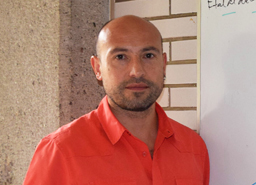Conferencia del 28 de octubre de 2019

COORDINA LA CONFERENCIA:
Dr. Ivan Castillo Pérez
Departamento de Química Inorgánica del IQ-UNAM.
Conferencia en el Instituto de Química
Copper-dependent bacterial lytic polysaccharide monooxygenases (LPMOs): structure-reactivity relationships and engineering of the histidine brace motif
Impartirá: Dr. Christophe DecroosUniversidad de Marsella (Aix-Marseille Université).
Difusión y comunicación: Hortensia Segura Silva.
Entrada libre
RESUMEN
Lytic polysaccharide monooxygenases (LPMOs) are copper metalloenzymes secreted by fungi and bacteria (among others) that catalyze the oxidative cleavage of glycosidic bonds in recalcitrant polysaccharides such as cellulose or chitin – the two most abundant biopolymers on Earth. LPMOs have recently emerged as key enzymes for biomass breakdown in synergy with classical glycoside hydrolases, but also play important roles in pathophysiological processes such pathogenicity of several bacteria (virulence factor in some human and insect pathogens). Overall, LPMOs diversity is explored for applications in biotechnology (production of biofuels from biomass) and beyond. The topology of their solvent-exposed active site is unique among copper-containing oxygenases. The mononuclear copper(II) ion is coordinated by both the side chain nitrogen and the main-chain amino group of the N-terminal histidine and by another histidine side chain forming a motif referred to as “histidine brace”. This presentation will first focus on our current efforts towards the characterization of bacterial LPMOs with an unusual second coordination sphere using a combination of biochemical, biophysical (EPR), and structural techniques. Lastly, some preliminary data will be presented to highlight the versatility of the LPMO-scaffold to accommodate new metal binding sites, opening new avenues towards original reactivities.

